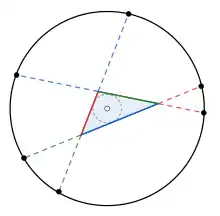Conway circle theorem
In plane geometry, the Conway circle theorem states that when the sides meeting at each vertex of a triangle are extended by the length of the opposite side, the six endpoints of the three resulting line segments lie on a circle whose centre is the incentre of the triangle. The circle on which these six points lie is called the Conway circle of the triangle.[1][2][3] The theorem and circle are named after mathematician John Horton Conway.

A triangle's Conway circle with its six concentric points (solid black), the triangle's incircle (dashed gray), and the centre of both circles (white); solid and dashed line segments of the same colour are equal in length
References
- "John Horton Conway". www.cardcolm.org. Archived from the original on 20 May 2020. Retrieved 29 May 2020.
- Weisstein, Eric W. "Conway Circle". MathWorld. Retrieved 29 May 2020.
- Francisco Javier García Capitán (2013). "A Generalization of the Conway Circle" (PDF). Forum Geometricorum. 13: 191–195.
External links
- Kimberling, Clark. "Encyclopedia of Triangle Centers".
{{cite web}}: CS1 maint: url-status (link)
This article is issued from Wikipedia. The text is licensed under Creative Commons - Attribution - Sharealike. Additional terms may apply for the media files.